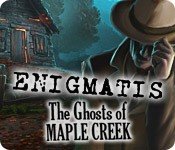Casual Collection - September 2011 releases

For a while it looked like September was going to be a light month of lite adventures, but then the deluge came and the kids weren’t the only ones back up to their eyeballs in homework. But work for us means fun for you, with plenty of choices to make. You may want to find out what happened after “The End” of a couple popular fairy tales, confront more demons, vengeful shamans, and wicked witches than you can shake a broomstick at, travel through time and towns to restore trapped souls, and live through a pair of deadly survival games. But which to pick? You don’t want to find yourself up Maple or Agony Creek (or that other one) without a paddle, so read on for the straight goods on the latest month of hidden object adventures.
Page 1: Mystery Legends: Beauty and the Beast, Enigmatis: The Ghosts of Maple Creek
Page 2: Haunted Legends: The Bronze Horseman, Echoes of the Past: The Citadels of Time
Page 3: Cursed Memories: The Secret of Agony Creek, Voodoo Chronicles: The First Sign
Page 4: Mystery of the Ancients: Lockwood Manor, Urban Legends: The Maze
Page 5: Oddly Enough: Pied Piper, Committed: Mystery of Shady Pines
Mystery Legends: Beauty and the Beast
by Robin Parker
After previously taking on Sleepy Hollow and The Phantom of the Opera, pixelStorm now brings us the third instalment of the Mystery Legends series, Beauty and the Beast. Set after the events of the original story, Belle has saved the Prince from his curse, but another setback has affected the life of the happy couple. The same wicked enchantress who cursed the prince in the first place – still feeling sore from being scorned the first time around – has now entrapped him in stone and broken his soul up into five crystal shards, which she then scattered throughout the land. As you explore many fantastical scenes, solving puzzles and scouring infrequent hidden object scenes as you go, you will meet a variety of friends and foes who will act to both help and hinder your quest.
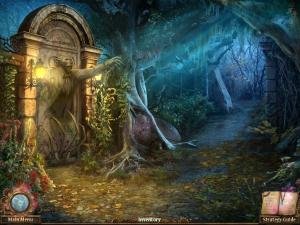 The traditional fantasy setting is a nice change of pace from the earlier mystery legends. This isn’t the Disney version of Beauty and the Beast, however, presented much more in the vein of the Brothers Grimm, with shadowy figures in the distance and dangers lurking down every rabbit hole – and let’s not get started on the spiders (arachnophobes be forewarned). One moment you’re experiencing enchantment and wonder in a fairytale forest or a quaint little cottage, and the next you’re surrounded by a much more foreboding atmosphere, even coming face-to-face with the evil enchantress herself. The animation and visual effects are impressive, and the character models are drawn in a very detailed realistic style.
The traditional fantasy setting is a nice change of pace from the earlier mystery legends. This isn’t the Disney version of Beauty and the Beast, however, presented much more in the vein of the Brothers Grimm, with shadowy figures in the distance and dangers lurking down every rabbit hole – and let’s not get started on the spiders (arachnophobes be forewarned). One moment you’re experiencing enchantment and wonder in a fairytale forest or a quaint little cottage, and the next you’re surrounded by a much more foreboding atmosphere, even coming face-to-face with the evil enchantress herself. The animation and visual effects are impressive, and the character models are drawn in a very detailed realistic style.
The music and sound effects add to the mood as well, with a good variety of themes preventing the common need for annoying repetition. Other sounds consist largely of atmospheric background effects and lots of magical sparkles and twinkles that you might expect from a fairytale. Although not used for every line of dialogue, voice work does feature extensively and it is all top notch – the enchantress is genuinely unlikeable and the pain of the prince feels all the more real through his convincing portrayal.
This game does feature a smattering of hidden object scenes, but in the balance this title leans more toward lite adventuring than item scavenging. The HOG scenes are in keeping with the regular in-game graphics, but it can be difficult to locate some of the listed objects on a crowded screen. None are interactively hidden behind other objects like in some games, but their small size can make them a little unclear. You’ll spend more time solving a fair number of traditional one-off puzzles like sliders, jigsaws, rotating puzzles, and arranging themed grid rows without any repeat images. These vary quite greatly from the very simple – spinning tiles around until they all face the correct way – to reasonably challenging. One requires guiding a knight to his castle along metal tracks, hitting every junction on the path but without passing any twice. Whilst not fiendish, it is the kind of puzzle that exercises the brain a bit more to strategise rather than just being trial and error. No puzzles will stump experienced players for an extended period of time, but a slowly charging skip button is available, even on the hardest of three difficulty settings.
Most of the other objectives feel more like multi-layered obstacles than simple fetch quests. For instance, to fix a broken ventilation pipe you need to fish the valve out of a pond using a net you’ve acquired elsewhere, and then still need to find the settings somewhere else before getting the pipe working correctly. This type of sequence does involve some backtracking, but in retracing your steps you are looking for particular items (some of which only become interactive once you begin a particular puzzle) instead of simply seeing if previously visited HOG scenes have become active once more.

There is an in-game map which also acts as a vague hint system, as it highlights any areas that have immediate objectives linked to them. Unfortunately, you cannot use this map to jump to those areas directly. The hint function highlights any area of interest on the current screen or indicates you’ve done all you can for now. The recharge time for hints seems particularly long, but the map alone will usually be enough to point you in the right direction. The Collector’s Edition includes a strategy guide as usual, but this one only gives you information on the current puzzles and objectives – even hiding hints until you click on them.
All in all, the main game weighs in at around five hours of gameplay, with the Collector’s Edition bonus chapter adding almost another hour to that total and wrapping up all loose ends in a more satisfying way. At the end of the main game, the enchantress still lingers after an epic battle, but the bonus chapter lets Belle and her prince finally get some closure on the rivalry. It also includes more action and “fight” scenes than the main game (albeit your adventure-style, puzzle-based variation, not a twitch and reflex affair). Add to that the fact that you can unlock the original novel to read after a successful playthrough and there is plenty to keep you busy, fully entertained while you’re at it. In fact, there is very little of the “beastly” side to either version of this title, which offers far more beauty to admire in both its structure and setting.
Enigmatis: The Ghosts of Maple Creek
by Shuva Raha
A sleek cinematic follows a terrified woman as she flees through a storm-swept forest, chased by a faceless malevolent entity till she finally collapses on the outskirts of the titular fictional town in Vermont, USA where Artifex Mundi's Enigmatis: The Ghosts of Maple Creek is set. The game starts as she regains consciousness, but not her memories – she recollects nothing that explains her precarious predicament, or the blood on her hands that isn't her own. The settlement hasn't weathered the storm any better, reduced to a messy heap of shattered housing, fallen trees and short-circuiting electric poles in the aftermath of the tornado. The damage, however, has also shaken loose secrets long buried within walls and under floorboards, and the cluttered wreckage is ideal for some riveting sleuth work, hidden object searches, and puzzle-solving.
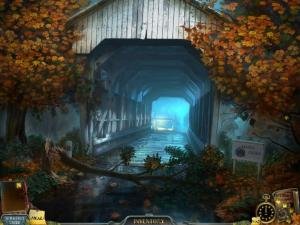 Some handy clues soon help our amnesiac protagonist discover the basic facts: she's a detective who was investigating the disappearance of a teenager, the latest of several young women gone mysteriously missing from the area over the past eight decades. It's up to you to scout the inexplicably abandoned town and its surroundings, which include a guesthouse, a chapel, some disheveled homesteads, a gas station, the nearby hiking trails and a sinister church. Only by piecing together the scraps of evidence – photos, newspaper articles, reports from past investigations – can you hope to solve the case before the evil consumes its newest victim, and likely you too.
Some handy clues soon help our amnesiac protagonist discover the basic facts: she's a detective who was investigating the disappearance of a teenager, the latest of several young women gone mysteriously missing from the area over the past eight decades. It's up to you to scout the inexplicably abandoned town and its surroundings, which include a guesthouse, a chapel, some disheveled homesteads, a gas station, the nearby hiking trails and a sinister church. Only by piecing together the scraps of evidence – photos, newspaper articles, reports from past investigations – can you hope to solve the case before the evil consumes its newest victim, and likely you too.
But Enigmatis guards its secrets closely and yields no easy answers during its six-odd hours. You're quickly drawn into a flurry of macabre discoveries, and suspicion veers between human cult and criminal adversaries, and supernatural ones like ghosts. Each assumption is backed by plausible evidence, and debunked rationally as more clues are unearthed. The quest is led systematically by the detective, but you're not relegated to mere mouse-driving: the collaborative gameplay allows you to analyse the leads and work out the correlations between them yourself.
The investigation favours inventory-based activities and object hunts over standalone puzzles. Searching the fourteen hidden object screens thrice each is repetitive, but not overly tiresome due to the stylish art. Some lists have an object or two which require minor interactivity to find, and in an annoying oversight, these hotspots remain active even after resolution, continuing to sparkle for your attention even during later revisits. Inventory quests are well-integrated with the plot and yield not only useful tools but clues and pieces of puzzles as well. Rewards are sometimes disproportionate to the effort required, like a convoluted excursion spanning hours to uncover an object of only mechanical value, but such missteps are rare.
There are fewer than a dozen logic puzzles, but quality trumps quantity, and each beautifully illustrated challenge, be it a jigsaw or a pattern match or a lock to be picked, is entertaining to solve. In an ongoing drag-and-drop puzzle that lasts throughout the game, you pin evidence items onto a wall and group them to either clarify the dilemmas or create more avenues for investigation. Mistaken links aren't fatal, but deducing correctly on your own provides a genuine sense of accomplishment.
Progress is linear, with only a couple of activities to do at a time. Your current objective is listed in a journal, which helpfully documents your observations according to related events and connects each goal to its specific set of clues, eliminating the usual pain of rifling through scores of pages for smidgens of relevant information. A map is drawn out as new areas are revealed, and on the easier of two difficulty settings it marks out locations with pending activities. Exploration can still be irritating, however, due to an unnecessarily complicated town layout (a large portion of which can only be reached by rappelling down from a balcony and crossing many derelict yards), and the order of quests, which force you to make this and other lengthy trips again, and again, and again.
Based in the verdant Appalachians, Maple Creek is predictably scenic, and the richly coloured, tastefully drawn screens showcase this appeal, albeit in a dark, gloomy way. Snooping around endangers you to some gasp-worthy moments, and the game consistently sustains a creepy tension. This undercurrent of terror is augmented by the soulful piano-and-cello soundtrack and ambient noises like the creaking of damaged buildings, tolling of church bells and the pounding of the protagonist’s heart. Some segments are voiced, like the animated cutscenes and certain conversations, and the performances are competent, barring one character whose weird hamming grates on the nerves. The onscreen text itself is crisp and easily understandable despite a few typos.
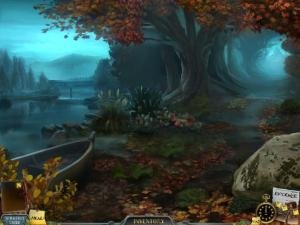 The main adventure wraps up with a cliffhanger that paves the way for a sequel, while the Collector’s Edition bonus play provides a prequel set decades earlier. The hour-long extension traces a past investigation into the case, and ties up some crucial loose ends of the main game even as it tears apart its unpleasant yet somewhat acceptable explanation with a centuries-old secret that ups the ante for the next episode by several notches in one fell swoop. Maple Creek of yore is depicted in hazy, rose-tinted shades, and it's delightful to compare the town then with its current iteration, though it has barely evolved over time. The music is sweeter – soothing almost – but the sense of doom is no less oppressive as you uncover clue after morbid clue. The gripping story bolsters the chapter’s easy gameplay, which features an abridged environment, basic inventory quests, five well-designed but simple puzzles, and five hidden object screens again visited three times each. And though you already know the ill-fated conclusion of the case, the finale is nevertheless gut-wrenching to witness.
The main adventure wraps up with a cliffhanger that paves the way for a sequel, while the Collector’s Edition bonus play provides a prequel set decades earlier. The hour-long extension traces a past investigation into the case, and ties up some crucial loose ends of the main game even as it tears apart its unpleasant yet somewhat acceptable explanation with a centuries-old secret that ups the ante for the next episode by several notches in one fell swoop. Maple Creek of yore is depicted in hazy, rose-tinted shades, and it's delightful to compare the town then with its current iteration, though it has barely evolved over time. The music is sweeter – soothing almost – but the sense of doom is no less oppressive as you uncover clue after morbid clue. The gripping story bolsters the chapter’s easy gameplay, which features an abridged environment, basic inventory quests, five well-designed but simple puzzles, and five hidden object screens again visited three times each. And though you already know the ill-fated conclusion of the case, the finale is nevertheless gut-wrenching to witness.
A casual adventure that keeps you guessing till the end is rare; rarer still is a CE expansion that thickens the plot instead of scraping out a few extra minutes of play. Enigmatis: The Ghosts of Maple Creek is a fabulously extruded mystery, and the bonus chapter is essential if you wish to learn the real secret (and trust me, if you like tense, twisted tales, you will). A few more, and tougher, puzzles would have upped the overall challenge, but the unsettling creepiness of the quaint rural town, the baffling mutterings of the peculiar townsfolk and some genuine frights embellish the intriguing story and smart production enough to create a chilling experience that will definitely haunt you even after the credits roll.
Haunted Legends: The Bronze Horseman
by Merlina McGovern
When the heavens open up and rains flood the land, the bronze horseman will ride again and bring judgment to all… With this ominous tone, ERS Game Studios’ Haunted Legends: The Bronze Horseman opens. But while the game is as beautiful as a polished bronze statue, a by-the-numbers-feel to its overall design makes it similarly hard to fully warm up to, though it is still an enjoyable lite adventure set amidst a wide variety of puzzles and hidden object scenes.
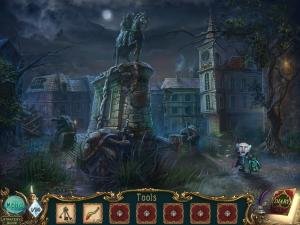 You play a detective who has been called to an 18th century town turned upside down by a deluge. Fearing this is the punishment for wickedness foretold in folklore, people begin buying crystals from an opportunistic vendor to protect themselves against the horseman, but they’ve been disappearing anyway. The mayor has called because his own son is missing, and as you begin your search for the boy, you’ll find clues he’s left behind from his own investigation. You’ll also catch continual glimpses of a creepy little gnome with an enormous head who seems to have something to do with the ill-fated crystals the townspeople have purchased.
You play a detective who has been called to an 18th century town turned upside down by a deluge. Fearing this is the punishment for wickedness foretold in folklore, people begin buying crystals from an opportunistic vendor to protect themselves against the horseman, but they’ve been disappearing anyway. The mayor has called because his own son is missing, and as you begin your search for the boy, you’ll find clues he’s left behind from his own investigation. You’ll also catch continual glimpses of a creepy little gnome with an enormous head who seems to have something to do with the ill-fated crystals the townspeople have purchased.
You’ll have to collect 24 of these crystals throughout the game, and they are part of the strange, off-kilter look of this world. The multicolored crystals contain the maddened, terrified faces of the poor townsfolk, having trapped their souls inside instead of offering protection. It’s never explained why the town is so obsessed with the bronze horseman, whose image is everywhere, and just as inscrutably the populace seems to have a passion for snails, as the buildings and structures are riddled with depictions of them. Elaborate stone gates are topped with large snail carvings with spindly horse legs sprouting from them. The strange aesthetic is rendered beautifully in darkened indigoes and cobalt blues, but there’s never any answers for why this town is portrayed in such a surreal style.
Enlivening each scene are a multitude of animations. Click on a window and a terrified woman quickly closes it. You’ll spot the repulsive gnome squatting and picking through a child’s clothing; when you attempt to catch him, he faces you, growls menacingly, and runs away. Lightning strikes the town square’s bronze horseman statue and the horse suddenly rears and leaps down to gallop away. Even the smaller animations are quite nice, such as a small snail slowly inching across a wall and leaving a trail of slime in its wake.
Adding to the life of each scene is an abundance of ambient sounds set amidst a rather jaunty (if repetitive) soundtrack filled with thumping cellos and soaring violins. An old painting creaks as it bobbles and then crashes to the floor, and an iron portcullis clanks down as it closes between you and a scared little girl. There are several characters voiced in the game, and the acting is well done for the most part. The mayor with his deep, aristocratic voice seems genuinely disturbed about his son’s disappearance, and his son sounds curious and energetic. The gnome's grunts and growls are both weird and menacing. The exception is little Lisa, whose voice clearly belongs to a much older woman attempting to sound like a terrified girl.
As you make your way through town, you’ll solve inventory puzzles to open a variety of doors and locks using items you find, some of them only through hidden object searches. There is nothing innovative about the item hunts, and as they begin to pile up they start feeling like busywork more than fun. This feeling is compounded by having to repeat searches in the same areas multiple times, occasionally even for some of the same objects. There are a few items highlighted that require interaction to reveal. These objects are usually not very tricky to find; many times they just involve clicking areas to zoom in closer for a better look, though sometimes you’ll have to combine items to create others, like warming up a hot beverage. But if you’re struggling to locate these harder-to-find connections, wait a bit on the regular difficulty level and sparkles will highlight the hotspots. If you still can’t find an item you need, you can click the handy rechargeable hint button.
Unfortunately, the developers have not provided hints for the main adventure. For the most part it’s not that difficult to determine where you need to go next, but if you miss a single hotspot in your travels it can be difficult to figure out where you’ve gone wrong. Even the journal only provides a basic recounting of major scenes, which isn’t very helpful. The Collector’s Edition comes with a strategy guide, of course, but you’re on your own if you buy the standard version.
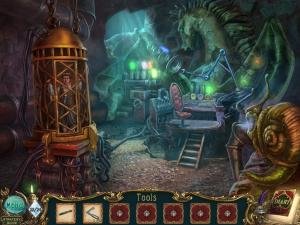
In addition to inventory puzzles, you’ll also encounter a wide variety of logic puzzles, all of which you can skip if they become too difficult. Some of them are quite creative, such as combining four elements in various ways to achieve something more complex like a steam engine. You’ll also have to muddle through cryptic blueprints to concoct potions and turn on machines. Some early puzzles are easy, but later ones become more complicated, such as a deceptively challenging bridge-building exercise using staggered planks. Even when you encounter familiar slider puzzles or rotating ring puzzles, there is usually something to make them interesting, such as including two areas to complete simultaneously. The puzzle instructions are helpful for the most part, though a few puzzles had so many elements I found it difficult to determine how to start.
After three and a half hours, the game ends rather abruptly, going out with a whinny rather than a bang. Your quest to help the mayor may be successful, but you’ll have to play the Collector’s Edition’s bonus chapter if you hope to capture the ne’er-do-well gnome. This bonus section is rather short, however, clocking in at only about 30 minutes long. It turns out there is a secret room in the mayor’s abode that you hadn’t yet discovered, and you’ll also get to explore a few new areas such as a garden area and gazebo.
There’s an ominous vibe to this tale of a town obsessed with a horseman and undone by its own vices and fears, and wonderful graphics and animations propel you through this bizarre story. These elements combine to make the game generally worth playing, if never particularly noteworthy. You won’t find any innovations here, and it can feel a little staid at times, but if your vice is an addiction to puzzles and gorgeous explorations, you won’t mind tempting bitter judgment by giving in to Haunted Legends: The Bronze Horseman.
Echoes of the Past: The Citadels of Time
by Jack Allin
By their very nature, echoes are a whole lot like the sounds immediately before them, but fading in impact over time. So perhaps it’s a fitting theme for Orneon’s Echoes of the Past: The Citadels of Time, the third iteration of a series that is starting to feel awfully familiar, and losing some of its appeal in the process. There is still a wealth of quality puzzling and hidden object adventuring to be found within the stone walls of the Orion family’s royal palace, but by this point it’s hard not to feel like you’ve heard it all before.
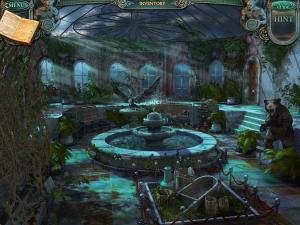 If you’re new to the Echoes series, you’re actually better off, especially since there’s really no plot to catch up on: A haggardly old witch is intent on cursing the same family over and over again for reasons only she knows, and it’s up to you to traverse the palatial halls, solving her fiendish puzzles to reverse the latest enchantment and restore order once more… at least until the next game. You’ve stopped her twice already, but ever undaunted, she’s back for more and this time she’s messed with the time stream. A special clock constructed by the royal scientist allows travelling through time, but the witch has made off with several components and scattered them in various eras, trapping each period’s inhabitants in a ghost-like imprisonment of time.
If you’re new to the Echoes series, you’re actually better off, especially since there’s really no plot to catch up on: A haggardly old witch is intent on cursing the same family over and over again for reasons only she knows, and it’s up to you to traverse the palatial halls, solving her fiendish puzzles to reverse the latest enchantment and restore order once more… at least until the next game. You’ve stopped her twice already, but ever undaunted, she’s back for more and this time she’s messed with the time stream. A special clock constructed by the royal scientist allows travelling through time, but the witch has made off with several components and scattered them in various eras, trapping each period’s inhabitants in a ghost-like imprisonment of time.
To find all the parts you need and repair the clock, you’ll need to warp in and out of various time portals. The problem is, it’s still the same castle, and so much of it will feel the same to returning players. With one welcome breath of fresh air down at a lake, you’ll spend time visiting the same towers, dungeons, crypts, hallways, and bedrooms as before, only slightly spruced up since last year’s installment. Apart from one modern-day surveillance room with video feeds and a particularly medieval-feeling courtyard scene, there really isn’t much to distinguish the eras anyway. If they were doors instead of portals you were travelling through, it really wouldn’t make much difference – and frankly, I could have done without the short warping animation each and every time I passed between timelines.
And pass between them you will. A LOT. Each era has a handful of screens to explore, and though only two are ever open at any given time (as well as the hub-like period in which you start), the developers seem intent on maximizing backtracking. Often you’ll need to scour far-flung corners for multiple statues, insignias, metal plates, and bas-reliefs, only to hoof it back to where they’re needed. That’s if you can remember. The area is too confined to get lost, and for the first time this series actually offers a helpful hint system, but because the requirements are so abstract and random, without a map it’s easy to lose track of which component is needed where. There are a few standard inventory uses of tools and common instruments, and these feel far more intuitive, though even they can be stretched thin, like a door that requires three different keys. You’re never more than ten or so clicks away from where you need to be, so it’s not a huge ordeal, but all the arbitrary to-ing and fro-ing does begin to grate after a while.
Of course, the reason for all the legwork is that there’s so much to do. Like its predecessors, Citadels of Time is crammed full of puzzles of all shapes and sizes. There are garden variety math and weight puzzles, sliders, misaligned levers, jigsaws, tile swaps, and ring rotators, but there are also some lesser-seen types like navigating colour-based grids, juggling balls into place as a mechanical clown, and painting stained glass using shape and colour sequences. Unfortunately, the designers chose to repeat the more unusual puzzles several times, thereby negating the novelty. Difficulty ranges from extremely easy (pure trial-and-error button sequences) to very hard (piecing together broken tumblers to connect all at once), though of course any can be skipped once you have all the requisite components.
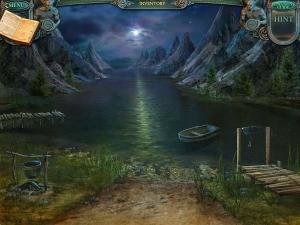
Some items can only be acquired through hidden object hunts, but these don’t occur too frequently. Along with the traditional lists of items, some of which require a few interactions to complete, the game mixes in a few “replace the item” tasks as well, which are somewhat more difficult. Each search provides a fairly close look through the clutter, which is good, since the main adventuring screens are often rather distant views of open, empty areas. The hand-drawn realistic artwork is nice enough, but the sparseness of many scenes makes the visuals seem bland overall. Each character you meet (once unfrozen from time) is competently voiced, but the music is the most repetitive element at all, and the pleasant but atmosphere-neutral tune wears out its welcome long before the end.
Given the density of puzzles, you won’t soon reach that point, as the main game should take between 4-5 hours to complete. The bonus chapter in the Collector’s Edition is entirely unnecessary in terms of storyline, but its extra hour of play time was easily my favourite part of the game. Here you must travel way back in time to prevent a prototype clock from falling into the witch’s hands, which means you finally break free of the castle and get to explore an ancient land of standing stones and unusual monuments. Hidden object searches are limited to straightforward item scavenging, while most of the puzzles are again familiar, though one letter-and-symbol matching challenge and a mirror pattern exercise are quite interesting. The only downside is, the chapter ends with an absurdly abrupt and anti-climactic finale. But it’s really not the end in any case, as the witch once again vows a “next time” before you’re through. For puzzle fans, another Echoes of Time should be good news, but here’s hoping the increasingly repetitive series sounds a few more original notes in future installments.
Cursed Memories: Secret of Agony Creek
by Jason L Blair
VAST Studios' Cursed Memories: Secret of Agony Creek starts out strong. A brief cinematic sets the stage with a mine collapsing after a planted bundle of dynamite takes out one of the shaft's main supports. As the shattered earth fills the tunnel, you are pulled from the rubble by an unknown person. After dragging your body into a cabin, gloved hands shackle you down and leave you for some unstated purpose. And there you come to, fixed to the floor of a dirty cabin, all alone. A call to your cell phone fills in the blanks: You are the latest intended victim in a series of murders. The mysterious caller on the other end offers a plan and the possibility of escape. You just have to get to her. Sounds exciting, but unfortunately this cool promise is never fulfilled as the story moves along increasingly implausible twists and turns.
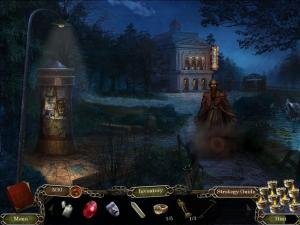 The gameplay has similar promise, and is somewhat more successful in delivering on its potential. Simple inventory puzzles get you into the game and out of immediate danger. From there you encounter hidden object screens and codes on slips of paper as you work your way toward a wider variety of puzzles, some of which are very good and offer a fair bit of challenge. The game provides some fun twists on familiar sliders, pattern puzzles, and others, with an especially beguiling color-mixing challenge as a standout among them. These puzzles are rare though, and their goals occasionally obtuse. Meanwhile, the hidden object searches are particularly well done. The developers opted for clever camouflage and obscured placement over sheer volume, causing for some very rewarding finds and a-ha! moments. While you return to some screens for a second round, most of them are one-shot deals. Each hunt routinely has at least one interactive element, though sometimes they are used to hide away objects and other times they're just flavor, yielding nothing.
The gameplay has similar promise, and is somewhat more successful in delivering on its potential. Simple inventory puzzles get you into the game and out of immediate danger. From there you encounter hidden object screens and codes on slips of paper as you work your way toward a wider variety of puzzles, some of which are very good and offer a fair bit of challenge. The game provides some fun twists on familiar sliders, pattern puzzles, and others, with an especially beguiling color-mixing challenge as a standout among them. These puzzles are rare though, and their goals occasionally obtuse. Meanwhile, the hidden object searches are particularly well done. The developers opted for clever camouflage and obscured placement over sheer volume, causing for some very rewarding finds and a-ha! moments. While you return to some screens for a second round, most of them are one-shot deals. Each hunt routinely has at least one interactive element, though sometimes they are used to hide away objects and other times they're just flavor, yielding nothing.
On normal difficulty the hint system regenerates in under a minute, but it’s only good for showing general areas of interactivity or hidden items as it doesn't direct you beyond that. If you're lost, you have to use a hint on every screen until you find something you haven't solved or explored yet. Standalone puzzles can be skipped, but the meter that allows you to do so fills at a considerably slower rate, ensuring you have to spend a good amount of time with each puzzle.
The story is primarily told via short cinematics and is supplemented by scattered objects such as newspaper clippings and hazard notices. The writing is solid enough even when the plot becomes a mess of mystical elements about halfway through. I don't demand literary perfection in my casual titles, which tend to be built upon the most tenuous of premises, but this one stretches credibility to the snapping point, heaping conspiracies upon ghosts upon planted memories before hand-waving away the significance of the entire experience toward the end.
The game's art style is typical for casual adventures, with slightly stylized but mostly realistic characters and environments. The cabin and the surrounding town, which includes a church, theater, and police station to explore, are nicely dressed with appropriate (and sometimes gruesome) details such as blood smears, flashing police lights, and rain fall. The cinematics have only minimal animation, but the voice work goes a long way toward selling the tension and characters. The sound is equally competent with some nice effects work, like rain slapping against metal. The musical score ranges from orchestral to percussive and does a good job of complementing the atmosphere, especially in the early stages.
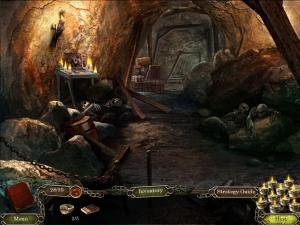
At just two-and-a-half hours, the main game is over quickly but ends satisfactorily enough. The Collector's Edition comes with the usual wallpapers, soundtrack, and concept art, but these are not automatically unlocked. Rather, they only become available as you find and collect bags of gold hidden throughout the game. Every ten bags unlocks a new level of perks, including “infinite puzzle” and “infinite hidden object” prizes that allow you to replay any puzzle or HOG from the main game. The bonus chapter continues on from where you left off with a whole new hospital environment to explore, putting you on the path of hunting down the person truly responsible for the predicament you’ve worked so hard to escape.
Whether or not the bonus chapter delivers on that, I can't really speak. About 25 minutes in, I encountered what I assume to be a glitch that prematurely ended the game with no apparent resolution. Worse still, I exited out to the main menu and attempted to access the bonus chapter again. This is when I discovered all the bonus material I had unlocked previously was now locked again. Bonus chapter, wallpapers, everything. I can't say whether this is a widespread issue or if I happened upon a rare-yet-major hiccup, but I include this as a caution to everyone.
Even without this glitch, which doesn’t apply to the standard version anyway, Cursed Memories: Secret of Agony Creek is hard to fully recommend. The thin story, sparse puzzles, and surprisingly short play time provide an ultimately underwhelming experience. Unless you’ve sailed through all the longer, deeper casual titles available this month, I suggest you skip over this creek and look for something that will provide much fonder memories.
Voodoo Chronicles: The First Sign
by Shuva Raha
In 1880, an expedition funded by an industrialist aptly named Coins plundered a tribal island while seeking an artifact that gives its possessors all they desire. In retaliation, a shaman cursed them, eradicating all but Coins and two henchmen, who escaped with the artifact and for the next twenty years reaped its benefits to their hearts' content. But the curse, undeterred by time and space, has finally caught up with Coins, and you, playing as private eye James Voodoo, are summoned to help solve his murder. This premise promises a gripping casual adventure, but Space Monkey's Voodoo Chronicles: The First Sign can't decide whether it wants to be a noir whodunit, a supernatural caper, a mythological mystery, or all of the above, and its story rapidly degenerates from a crime procedural into disjointed scenarios involving a weird cat, a wisecracking skull, a kraken and Norse gods, making you wonder by the end if you're still playing the same game you started. And despite the attractive art and lengthy five hour play time on hard mode, its puzzles are too easy and hidden object searches too tiresome at times.
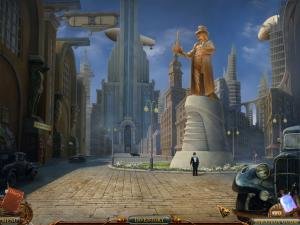 The investigation is based in and around Voodoo's messy office, but he also travels on an Orient Express-like deluxe locomotive to Coins's metropolis Richtown, races through a forest in a horse-drawn wagon with feral wolves in pursuit, sails on a storm-battered ship, and crash lands a blimp on the tribal island. Each location is a self-contained chapter of a few screens, which limits both the playing area and complexity since neither quests nor objects are transferred between chapters. Instead, every scene needs to be frequently revisited to find relevant hotspots activated since the last time you were there.
The investigation is based in and around Voodoo's messy office, but he also travels on an Orient Express-like deluxe locomotive to Coins's metropolis Richtown, races through a forest in a horse-drawn wagon with feral wolves in pursuit, sails on a storm-battered ship, and crash lands a blimp on the tribal island. Each location is a self-contained chapter of a few screens, which limits both the playing area and complexity since neither quests nor objects are transferred between chapters. Instead, every scene needs to be frequently revisited to find relevant hotspots activated since the last time you were there.
The main challenge comes from the 18 hidden object screens, repeated once each. Chock-a-block with random junk, these yield one usable object per turn. The clutter isn't a hindrance, but the screens are dark enough in large patches to warrant raising the monitor's brightness, and many items are made difficult to find by obscuring them under the interface elements or behind other objects till only barely-discernible portions are visible. The dozen standalone puzzles run the usual gamut of pipes, gears, switches, pattern matches and object assemblies, and while they are well-illustrated and relevant to their situations, they rarely hold you back longer than a minute or two. On the bright side, they reward you with two hints per completion to supplement the single (very) slowly recharging hint at your disposal during hidden object searches. Hints can also be collected by locating tiny skulls lurking on occasional screens. Surprisingly, you can’t access any of these hints while you explore, though given the confined areas that really shouldn’t be a problem.
Progress is linear, but proceedings are confounding nevertheless as the story skips forth in fits and starts, launching arcs and characters which bear little or no relation to each other: the natives are trying to derail the investigation; a mysterious girl needs constant saving from strange situations; a missing gangster is replaced by a voodoo doll; a detective driven insane by the curse (or the case, it's unclear) is levitating in an asylum; storms and sea monsters are destroying ports and cantonments; a snarky disembodied skull like Monkey Island’s Murray appears from nowhere; a cranky cat isn't what it seems to be, nor is the island when it's finally located. The ambition in attempting to string together such diverse topics and locations to create a complex stage for the adventure is evident, but little is explored in depth or explained clearly enough, relegating the game to a progression of dioramas. Voodoo himself is a crusty, scientifically-inclined gumshoe who starts strong, but even he can do little but gape at the increasing peculiarities as time goes on.
The big plus of The First Sign is the charming art, which alternately seeps decadence and reeks of grime. Scenes like the gas-lit city centre, the port at dusk, and swanky Richtown with its skyscrapers and hovering blimps, are eye-catching and detailed with fine animation like sweeping clouds, wavering shadows and steaming valves. Cutscenes are quite fascinating, particularly the Coins Express rolling into a station billowing plumes of white smoke, an orchestral recital by toy monkeys, and a burning zeppelin crashing into the island. Meanwhile, wandering aboard the lurching train, especially the brief ride atop it, is as close to reality as such animation can get.
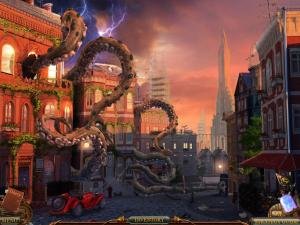
The background score varies from jazz-infused tracks in town to Oriental fusion on the island, but the audio winner is the multi-layered ambient effects that effectively recreate each milieu, be it a bustling city or a burning train. There is substantial dialogue, and the full game is voiced, even the briefest cameos. Voodoo's gravelly voice, the skull's cackle and the mobsters' over-the-top Italian drawls are in sync with the drama, but other characters run amok with accents and create noticeable dissonance. English translation of onscreen text is erratic and mistakes riddle newspaper headlines, but they still recount Coins's history efficiently.
The baffling conclusion of the main game may have you scrambling for the Collector's Edition bonus chapter for an explanation, but there's none coming. Instead, it’s a prequel that has neither story nor substance, nor any useful impact on the main plot. Here you play as the mystery girl who has to save native children trapped by Coins before the he activates the artifact. Five screens stuffed with typical items are partnered by three equally uninspiring hidden object dumps that follow no rules of era or location. There are no solitary puzzles, and set by default at 'easy', the chapter spews step-by-step directions to solve the juvenile inventory quests while heaping indignities on you, like forcing you to find a rope even as one you have just used (and inexplicably discarded) dangles in your face. This segment is also voiced, but the natives sound suspiciously similar to each other and their British-accented saviour. Luckily (and yet equally inexcusably), the torment lasts only fifteen minutes before the it terminates with the suddenness of a power-cut.
Voodoo Chronicles seems intended to be a series about Voodoo's cases, since this edition has no relation to the craft except for some hex bags and a couple of gratuitous references to Haiti. But any crime story, even one with supernatural elements, must have logical clarity that connects the dots with plausibility instead of distracting with mumbo-jumbo. The First Sign has all the elements of a good hidden object adventure: a plot with potential for twists; vibrant art and animation; an engaging lead; some interesting guest stars, and numerous obstacles to overcome across a variety of locations and situations, but it squanders its opportunities with tedious gameplay and incomprehensible storytelling. As a result, the main adventure is ultimately just average and the CE expansion is a joke, though the attempt to step away from the trodden turf makes you hold out hope for Voodoo's future assignments.
Mystery of the Ancients: Lockwood Manor
by Jack Allin
It’s fitting that the main objective in Mariaglorum’s Mystery of the Ancients: Lockwood Manor is explicitly following a ritual book’s instructions for banishing a demon. Not because the game is plagued by demons itself, fortunately, but because this is essentially a by-the-book hidden object adventure through and through. If a Casual Adventure 101 handbook really existed, this game would follow that formula to the letter, including its secluded house setting bathed in eerie moonlight, arbitrary inventory items protected by contrived puzzles, and repeating hidden object searches along the way. The derivation doesn’t make it a poor game by any means, but it rarely ventures outside of safe, familiar territory, resulting in a solid but unremarkable title overall.
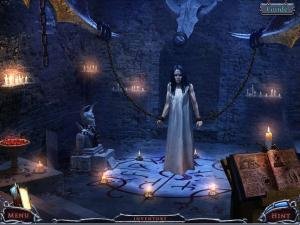 The story begins with little preamble at all, as you arrive at the titular family estate to rescue a friend in crisis. And indeed, no sooner than you arrive do you see your pal tying his girlfriend up in chains. A fair maiden to rescue! Or maybe not, as the game does take some entirely foreseeable twists and turns once you start fleshing out the backstory through helpfully detailed journal entries scattered conveniently in your path. Suffice to say, the Lockwood family has been dabbling in dark arts for over a century, and the current generation is responsible for unleashing a demon from its magical stone prison. Whoops. Time to see if you really can get the genie back in the bottle.
The story begins with little preamble at all, as you arrive at the titular family estate to rescue a friend in crisis. And indeed, no sooner than you arrive do you see your pal tying his girlfriend up in chains. A fair maiden to rescue! Or maybe not, as the game does take some entirely foreseeable twists and turns once you start fleshing out the backstory through helpfully detailed journal entries scattered conveniently in your path. Suffice to say, the Lockwood family has been dabbling in dark arts for over a century, and the current generation is responsible for unleashing a demon from its magical stone prison. Whoops. Time to see if you really can get the genie back in the bottle.
Retrieving the items necessary for the ritual involves a great deal of hoops-hopping as you traverse the manor and its heavily blue-tinted surrounding environs. Though the realistic artwork never dazzles, it’s a reasonably scenic journey through such locations as a greenhouse, cliffside lighthouse, and the obligatory cemetery crypt, delving underground tunnels and breaking out of corpse-lined prisons in between. There are a few animations to help bring this world to life, from floating leaves to scurrying rats, along with a smattering of action-based cinematics, like a hilariously crooked attempt to hammer nails in. One disappointment is the demon itself, which is little more than a cheesy smoke-based monster who’s utterly unfrightening and surprisingly unthreatening for all its supposed wickedness. The soundscape does very little to foster the potentially ominous atmosphere either. While ticking clocks are appropriately tension-rousing, some actions have no effects at all. Blasting a wall with dynamite results not in a deafening BOOM, just more of the same overly-gentle piano and strings that accompany you throughout.
Despite the lack of resistance from the demon, there are still plenty of obstacles to overcome. Some are fairly organic, as you make rubbings for clues, sharpen blades, smoke out bees, and spark up the dormant lighthouse lamp, but many more are inexplicably puzzle-oriented. There’s no reason provided for why there are so many puzzles lying about, or why it’s necessary to solve one just to yield an ordinary household tool, so smooth integration is minimal here. Often you’ll need to track down missing components before you can solve one, whether it's coins, musical notes, candles, or mirror shards. These can be scattered far and wide and accumulated very slowly, making your current objective feel rather vague at any one time. There’s no map to pinpoint available tasks, and the journal records only pertinent story elements and clues, though the hint system will lead you screen by screen to the nearest solvable puzzle.
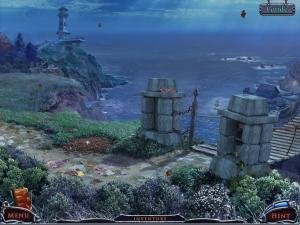
The puzzles themselves offer a decent variety, both in style and difficulty. All of them are standard types, including jigsaws, ring rotators, edge-matching, tangrams, and math and weight puzzles. Some are incredibly easy, but they do get more difficult as the game progresses, and several require clues found elsewhere (sometimes from multiple sources) before you can solve them. When not tackling these, you’ll be scouring hidden object scenes instead. These involve only non-interactive lists of items, most of which are fairly evident, though a few small items per screen will likely have you eyeing the fast-charging hint button, as will the tendency for some objects to be nothing more than simple line drawings. The HOG scenes occur regularly and many are repeated, though always for different objects. They are also guilty of the “activate anywhere, anytime” syndrome that plagues many adventures. This requires the occasional random backtrack, though for the most part the game does a decent job of keeping you in the same general vicinity before cleverly looping you back around to earlier scenes when needed.
Even with a bit of repetition, the main game can be finished in roughly three hours, with a rushed but reasonably conclusive ending… at least until the brief teaser that the demon isn’t quite gone for good. That’s where the Collector’s Edition bonus chapter comes in, sending you back into the fray once more. The property now blocked off by swirling black clouds, you’ll spend most of your time indoors, but you’ll finally be able to explore the previously inaccessible second floor. Puzzles are once again a mix of traditional tropes, this time including Lights Out, sliders, and overlapping strands. There’s enough here to keep you busy for another good hour, but the limited settings makes it feel a bit restrictive. The second ending resolves the demon’s fate once and for all, though the brief cutscene finale once again feels rather anti-climactic. Either way, Mystery of the Ancients won’t offer you anything you haven’t seen before, but if you’re just looking for the usual secluded-house-in-peril casual adventuring you’ve come to expect, it’s worth booking a visit to Lockwood Manor for more of the same.
Urban Legends: The Maze
by Jack Allin
While most reality TV shows are just deadly dull, the survival show in Elephant Games’ Urban Legends: The Maze proves truly deadly to its participants. When the live viewing of the final episode is abruptly cut short, the producers chalk it up to technical difficulties, but the contestants are never heard from after that. Now their families have hired you to investigate, so it’s off to the studio sets of The Maze, where you’ll soon find yourself caught up in a sadistic villain’s deadly games yourself, solving numerous puzzle and collecting objects both hidden and in plain sight along the surprisingly varied way.
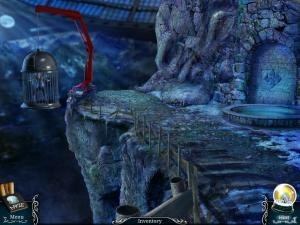 The television studio setting gave the developers plenty of freedom to be creative, as you’ll travel to such “locations” as a ship, cemetery, cliffside observatory, and even a dungeon prison when things start to go poorly. Each is designed in a distinctive hand-drawn style, often with muted colours to foster an eerie, ominous atmosphere. Although looking a little washed-out at times, there is plenty of detail in each scene, some of them clearly intended to serve as artificial backdrops for the TV show itself. There’s a nice array of ambient animation and short cinematics as well, from a landslide to swarming bats to the periodic presence of your nemesis, who appears always just out of reach, always one step ahead in his wicked plots. There is no voice acting at all, which undermines the drama of these encounters somewhat, but the sporadic music – which consists more of disturbing, discordant tones than actual tunes for the most part – and authentic sound effects do their part in keeping the mood sombre and tense.
The television studio setting gave the developers plenty of freedom to be creative, as you’ll travel to such “locations” as a ship, cemetery, cliffside observatory, and even a dungeon prison when things start to go poorly. Each is designed in a distinctive hand-drawn style, often with muted colours to foster an eerie, ominous atmosphere. Although looking a little washed-out at times, there is plenty of detail in each scene, some of them clearly intended to serve as artificial backdrops for the TV show itself. There’s a nice array of ambient animation and short cinematics as well, from a landslide to swarming bats to the periodic presence of your nemesis, who appears always just out of reach, always one step ahead in his wicked plots. There is no voice acting at all, which undermines the drama of these encounters somewhat, but the sporadic music – which consists more of disturbing, discordant tones than actual tunes for the most part – and authentic sound effects do their part in keeping the mood sombre and tense.
Though he taunts you and warns you, it’s never really clear why your grotesquely-masked adversary is toying with you the way he is. But he’s clearly serious, as you’ll find each contestant caught in a deadly trap, whether it’s trapped in a bathysphere, hovering over spinning propellers, or hanging precariously over a cliff. Not only will you need to free each of them from peril, you must avoid such fates of your own, as you’ll be confronted by bear traps, quicksand, piranha-filled pools (naturally concealing an item you need), and even a live leopard in a restroom. You’re never in any real danger, but the jeopardy is simulated decently, keeping you on your toes as you attempt to repair a weather control system gone haywire, start the fire-alarm sprinklers, fix a telescope, forge a key, mix solvents, and even “pilot” a helicopter.
Not all tasks feel quite so organic, however. Three different times you’ll need to collect scattered coins to buy absurd items from a vending machine, and again later to operate a directional racing minigame. Often the items you need are far apart, and though the game confines each new area to a handful of screens each, there would still be lots of backtracking if not for the handy map, which not only shows you areas with currently solvable objectives, but allows you instant transport to get there. It’s a shame that objectives aren’t a little more intuitive, as you may come to rely on this feature more than you’d like. The journal is fairly useless at doing anything but recording necessary clues, and it can be hard to find interactive hotspots, though these will twinkle intermittently if you wait.

There are a number of fairly cluttered hidden object scenes to scour, but they never repeat and there are no interactive elements, making them quite easy to blow through quickly in your travels. You’ll spend far longer on the many logic puzzles that await you. Though these challenges are ostensibly to test your will to live, really they do more to test your wits – and sometimes your patience. At first there seems a nice mix of varied tasks, from identifying correct wire lengths to tangrams to grid-based minigames, but before long there’s an increased reliance on rotation puzzles and sliders. Even when you think you’ve found a traditional puzzle like connecting gears or pipes, it may turn out to be a slider in disguise. There are other puzzle types as well, from equalizing fluids to a domino-based Sudoku, some of which can be extremely challenging due to the vague instructions provided. I’d still never have solved a particular match-the-edges tile puzzle if not for the fast-charging skip button.
For a non-Collector’s Edition game, Urban Legends is quite a substantial adventure, ending with a suitably dramatic if rushed-feeling climax. The density of the puzzles ensures this isn’t a short game, likely clocking in at four-plus hours if you don’t bypass many obstacles. And really, if you don’t like puzzles, you should probably look elsewhere for your casual fix. The hidden object scenes are little more than speedbumps in your path, and though the studio conceit offers a nice range of “pavilions” to explore, you’ll spend much of your time backtracking (or map-transporting) between them fetching the next tool or missing obscure part to solve yet another improbable logic puzzle. The premise is certainly compelling, the mood tense, the villain appropriately menacing, but there really isn’t much to the story beyond "chase bad guy, free contestants, live to tell the tale". In the end, it’s really all about the puzzles, and there’s much for puzzle-lovers to dive into here if you don’t mind a fair bit of repetitive similarity. Saw may have had its Jigsaw, but The Maze has a whole lot of sliders instead.
Oddly Enough: Pied Piper
by Jack Allin
The legend of the Pied Piper is one of those popular fairy tales with a horrific ending that would probably keep you up at night if you really thought much about it. Nothing like a little child abduction to get your shackles up. Whatever happened to happily ever after? But now there’s a chance to discover the fates of the children who followed the colourful, vengeance-seeking flutist after he was denied rightful payment by the townsfolk of Hamelin. Better yet, in GO! Games’ Oddly Enough: Pied Piper, you’ll have the chance to rescue the children from the Piper’s tower and finally give him what he’s owed. To do that, however, you’ll first need to solve numerous puzzles and scour a variety of dark but whimsical hub-based environments, though it won’t take you very long to get through them all.
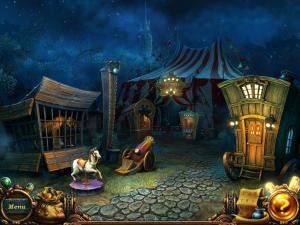 Oddly Enough is aptly named, because it is indeed a fairly odd bird among casual adventures. And I mean that in a good way. Rather than sending you on an every-expanding adventure that requires endless legwork to explore, here the game advances through a series of four different hub worlds covering the town of Hamelin and outlying forest, a carnival, and the Piper’s tower itself. Each consists of five or six locations branching directly off a central screen, so technically you’ll be doing a lot of “backtracking” between them, but never more than two screens at a time to get to your next destination. A map to keep track of current objectives would have been nice, but certainly none is needed to help with orientation, as it’s impossible to get lost.
Oddly Enough is aptly named, because it is indeed a fairly odd bird among casual adventures. And I mean that in a good way. Rather than sending you on an every-expanding adventure that requires endless legwork to explore, here the game advances through a series of four different hub worlds covering the town of Hamelin and outlying forest, a carnival, and the Piper’s tower itself. Each consists of five or six locations branching directly off a central screen, so technically you’ll be doing a lot of “backtracking” between them, but never more than two screens at a time to get to your next destination. A map to keep track of current objectives would have been nice, but certainly none is needed to help with orientation, as it’s impossible to get lost.
The Pied Piper’s world is a surreal and slightly magical one, though given the possibilities it ends up feeling fairly subdued. You’ll encounter sunglass-wearing gargoyles, talking furnaces (amusingly coughing from smoke inhalation), shrink ray machines, and animatronic bike-riding generators, but for the most part these are just backdrops for a number of fetch and repair tasks like pacifying an angry cat, waking a snoring blacksmith, charging a robot’s batteries, and powering up a toy steam train. Much of the muted atmosphere comes from the artwork, which is nicely hand drawn with slightly skewed perspectives and cartoony architecture but largely done in nighttime blues and stone tower greys, with little ambient animation bringing it all to life. The music is a pleasant enough fantasy-like minstrel tune (though surprisingly flute-free given the premise), but it repeats endlessly and adds little to the mood.
There are a fair number of repeating “hidden object” screens to search, but these too are different than most games. They are fragment hunts at heart, but rather than just random chunks of objects, here you’re searching for actual components to make more complex items like a cage, watch, crossbow, or chimney sweeper. It’s a small distinction that’s ultimately only cosmetic, but it makes the exercise feel far more organic than usual. It actually makes sense for you to search for broken parts of equipment you need, though the immersion is somewhat broken by the arbitrary activation of new hunts. Alas, if only they were more challenging. Finding the handful of silhouetted items on each screen is incredibly easy given the close-up views and relative scarcity of clutter. That might have been okay if you were required to assemble the tools yourself once each item is found, but this is done automatically.
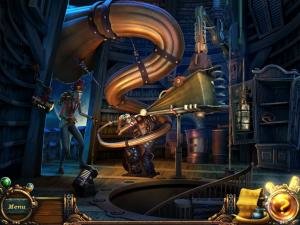
This ease of gameplay extends to the puzzles as well, with perhaps a few exceptions. Some minigames are brain-dead simple, like fishing for items, guiding a coin into a mechanical fortune teller’s mouth, and following a Ouija board planchette with the cursor. Several are fairly standard types, including Lights Out, adding grid rows into sums of 15, and arranging masks into clued positions. The only real challenge is likely to come from a couple of twiddleware puzzles, as you rotate misaligned rings and numbered tiles into place, which are more trouble than they’re worth. Another puzzle is challenging only due to the omission of a key detail in the instructions (when in doubt: click faster!). The many inventory puzzles are fairly straightforward as well, though it can be hard to find all the hotspots on the harder of two difficulty settings, particularly since the cursor doesn’t always change to indicate them, forcing you to click randomly at times for feedback.
Even the main task of collecting ten gold coins for the Piper proves to be remarkably easy, with many discovered in open and obvious places. The end result is not only an easy game, but a short one as well, as you can finish in less than two and a half hours all told. That makes my final recommendation a cautious one. I quite enjoyed the streamlined gameplay and better integration of the hidden fragment searches, and there’s just enough fantasy elements to give the environments an entertaining touch. But there’s no getting around the fact that your tasks are simple and the adventure over all too soon. So really it all comes down to what you value most in your casual games. It’s fun while it lasts, but when it’s time to pay the piper, you may just find that you haven’t quite gotten your money’s worth.
Committed: Mystery of Shady Pines
by Jack Allin
If the thought of yet another amnesiac-protagonist-locked-in-twisted-psychiatric-hospital premise is enough to drive you a little bonkers yourself, you should probably close your eyes and try to block out any knowledge of Fugazo’s Committed: Mystery at Shady Pines. But if your sanity can withstand being institutionalized for one more hidden object adventure, you may just enjoy exploring the dreary, disturbing confines of its setting as you attempt not only to recover your own memory, but to save your fellow patients and an innocent little girl from the psychotic experiments of the attending physician along the way.
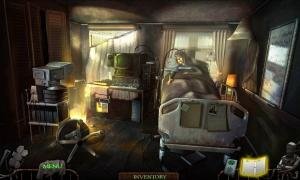 Shady Pines isn’t so much an asylum as it is a long-term care hospital for comatose patients, though “care” is a dubious term in this case. The reason for your incarceration is established through a series of cinematic stills in which you, a 32 year old woman, discover that you’ve been the victim of a mugging. With vague recollections of a doctor attempting to wake you up, you finally regain consciousness to find yourself strapped to a hospital bed. That can’t be good. After wriggling yourself free, rummaging through the trash for clues and doing a little crafty lockpicking, you begin to explore the empty, run-down hallways. There you soon learn that despite the soothingly creepy hospital propaganda messages playing occasionally over the loudspeaker, there is something very sinister going on here, and it’s up to you to get to the bottom of it.
Shady Pines isn’t so much an asylum as it is a long-term care hospital for comatose patients, though “care” is a dubious term in this case. The reason for your incarceration is established through a series of cinematic stills in which you, a 32 year old woman, discover that you’ve been the victim of a mugging. With vague recollections of a doctor attempting to wake you up, you finally regain consciousness to find yourself strapped to a hospital bed. That can’t be good. After wriggling yourself free, rummaging through the trash for clues and doing a little crafty lockpicking, you begin to explore the empty, run-down hallways. There you soon learn that despite the soothingly creepy hospital propaganda messages playing occasionally over the loudspeaker, there is something very sinister going on here, and it’s up to you to get to the bottom of it.
Your tour of the hospital not a scenic one. Shady Pines is shady, all right, with flickering lights dimly illuminating a decrepit building that looks and functions more like a prison. One patient's room is “decorated” with torn drapery and peeling wallpaper, and the hallways are lined with dingy green and grey cracked walls and industrial tiles. There are even macabre touches like a mannequin trapped in a puzzle-locked straightjacket and a skull in the cobweb-strewn reception area. (Pretty sure those weren’t in the brochure!) The dismal colour scheme is further washed out by a noise filter applied to the game’s graphics, making the visuals feel even grittier.
Unfortunately, this can make it harder to find hidden objects. Searches consist of straightforward item lists and the screens aren’t overly cluttered, but the tendency to significantly conceal items behind others may still drive you to the hint button on occasion. Object hunts don’t occur frequently, but (at least some) do eventually repeat, at times in unexpected places. Fortunately, the map highlights any areas with current objectives and active HOG screens, minimizing the guesswork if not the backtracking. That’s good, because there are no additional hints to guide you, and the journal records only basic story elements. As always, there are a variety of inventory and standalone puzzles as well. Along with jigsaws and misaligned buttons and electronic wave patterns to match, there are keypad codes to crack, broken elevators without fuses, a nurse’s Solitaire game to finish, and mannequins needing clothes…
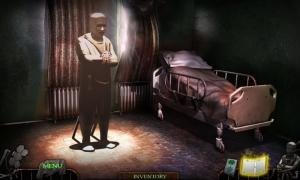 Wait, what? Well, yes, in an intriguing sequence, you somehow enter the mind of another coma patient, who dazily recites family characteristics in riddle-like fashion while you match clothes in the correct order to fit them. How you’re able to project yourself into dreams like this wasn’t explained in the limited time I played, but clearly there is more going on than meets the eye. That becomes even more apparent when you meet up with the frightened little girl whose identity may throw you for a loop. And why is the doctor so determined to restrain her, yet seems oblivious to your presence? Presumably these questions are answered later in the game, and I’ll admit, they certainly piqued my curiosity. I had to settle for discovering snippets of background from scattered doctor recordings. These tapes are all fully voiced, as are the characters you meet. The actors do a reasonable job, except (as always) the little girl who clearly isn’t performed by one. The sombre music meanwhile, does a good job of maintaining a disquieting atmosphere without ever really drawing attention to itself.
Wait, what? Well, yes, in an intriguing sequence, you somehow enter the mind of another coma patient, who dazily recites family characteristics in riddle-like fashion while you match clothes in the correct order to fit them. How you’re able to project yourself into dreams like this wasn’t explained in the limited time I played, but clearly there is more going on than meets the eye. That becomes even more apparent when you meet up with the frightened little girl whose identity may throw you for a loop. And why is the doctor so determined to restrain her, yet seems oblivious to your presence? Presumably these questions are answered later in the game, and I’ll admit, they certainly piqued my curiosity. I had to settle for discovering snippets of background from scattered doctor recordings. These tapes are all fully voiced, as are the characters you meet. The actors do a reasonable job, except (as always) the little girl who clearly isn’t performed by one. The sombre music meanwhile, does a good job of maintaining a disquieting atmosphere without ever really drawing attention to itself.
I can’t speak for the quality of the rest of the game, including the bonus chapter offered in the Premium Edition, but despite my skepticism about its clichéd premise going in, Committed: Mystery at Shady Pines managed to pull me in with a distinctive personality of its own. It’s creepy without being scary, disturbing without being gory, and the parapsychology angle adds a welcome twist, continually teasing out a compelling mystery at a slow but steady pace. What is the doctor up to in this twisted facility? Why doesn’t the little girl recognize you when it seems like she should? How are you able to project yourself into other people’s minds? Is all this even real? You could drive yourself crazy pondering these questions, or you could just play the game instead.
Note: Adventure Gamers is a Big Fish Games affiliate.




